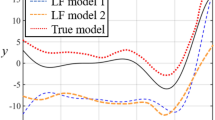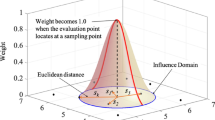Abstract
Multi-fidelity (MF) surrogate model has been widely used in simulation-based engineering design processes to reduce the computational cost, with a focus on cases involving hierarchical low-fidelity (LF) data. However, accurately identifying and sorting the fidelity of LF models is challenging when dealing with non-hierarchical cases. In this paper, we propose a novel non-hierarchical MF surrogate framework called weighted multi-bi-fidelity (WMBF) to solve this problem. The proposed WMBF has both the advantage of two non-hierarchical frameworks, the weighted sum (WS) and parallel combination (PC) techniques, leveraging an entropy-based weight to include multiple-moments statistical information. It offers not only a weight with more information but also a more individualized scaling function within the weighted-sum framework, additionally a more individualized discrepancy function compared with existing methods. Moreover, it provides the idea of exploiting Kullback–Leibler (KL) divergence (an entropy-based metric) to characterize uncertainty for calculating weight within the WS framework. To validate the performance of the WMBF, we conduct evaluations using several numerical test functions and one engineering case. The result demonstrates that the WMBF achieves both accurate and robust predictions with minimal computational cost.














Similar content being viewed by others
Data Availability
The MATLAB codes and the simulation data used to generate results are available upon request. All data and codes are available from the author upon reasonable request.
References
Sacks J, Welch WJ, Mitchell TJ, Wynn HP (1989) Design and analysis of computer experiments. Stat Sci 4(4):409–423 (ISBN: 0883-4237 Publisher: Institute of Mathematical Statistics)
Kleijnen JPC (2008) Response surface methodology for constrained simulation optimization: an overview. Simul Model Pract Theory 16(1):50–64. https://doi.org/10.1016/j.simpat.2007.10.001. (Accessed 2022-12-14)
Blatman G, Sudret B (2011) Adaptive sparse polynomial chaos expansion based on least angle regression. J Comput Phys 230(6):2345–2367. https://doi.org/10.1016/j.jcp.2010.12.021. (Accessed 2022-12-14)
Vafeiadis T, Diamantaras KI, Sarigiannidis G, Chatzisavvas KC (2015) A comparison of machine learning techniques for customer churn prediction. Simul Model Pract Theory 55:1–9. https://doi.org/10.1016/j.simpat.2015.03.003. (Accessed 2022-12-14)
Tripathy M (2010) Power transformer differential protection using neural network principal component analysis and radial basis function neural network. Simul Model Pract Theory 18(5):600–611. https://doi.org/10.1016/j.simpat.2010.01.003. (Accessed 2022-12-14)
Viana FA, Simpson TW, Balabanov V, Toropov V (2014) Special section on multidisciplinary design optimization: Metamodeling in multidisciplinary design optimization: How far have we really come? AIAA J 52(4):670–690
Yoo K, Bacarreza O, Aliabadi MHF (2022) A novel multi-fidelity modelling-based framework for reliability-based design optimisation of composite structures. Eng Comput 38(1):595–608. https://doi.org/10.1007/s00366-020-01084-x
Zhou Q, Wu J, Xue T, Jin P (2021) A two-stage adaptive multi-fidelity surrogate model-assisted multi-objective genetic algorithm for computationally expensive problems. Eng Comput 37(1):623–639. https://doi.org/10.1007/s00366-019-00844-8
Yang H, Wang Y (2022) A sparse multi-fidelity surrogate-based optimization method with computational awareness. Eng Comput. https://doi.org/10.1007/s00366-022-01766-8
Liu J, Yi J, Zhou Q, Cheng Y (2022) A sequential multi-fidelity surrogate model-assisted contour prediction method for engineering problems with expensive simulations. Eng Comput 38(1):31–49. https://doi.org/10.1007/s00366-020-01043-6
Fernández-Godino MG, Park C, Kim N-H, Haftka RT (2019) Review of multi-fidelity models. AIAA J 57(5):2039–2054. https://doi.org/10.2514/1.J057750. arXiv:1609.07196 [stat]. Accessed 2022-12-09
Jiang P, Xie T, Zhou Q, Shao X, Hu J, Cao L (2018) A space mapping method based on Gaussian process model for variable fidelity metamodeling. Simul Model Pract Theory 81:64–84. https://doi.org/10.1016/j.simpat.2017.11.010. (Accessed 2022-12-14)
Jin S-S, Kim ST, Park Y-H (2021) Combining point and distributed strain sensor for complementary data-fusion: a multi-fidelity approach. Mech Syst Signal Process 157:107725. https://doi.org/10.1016/j.ymssp.2021.107725. (Accessed 2022-12-14)
Zhou Q, Wang Y, Choi S-K, Jiang P, Shao X, Hu J (2017) A sequential multi-fidelity metamodeling approach for data regression. Knowl-Based Syst 134:199–212. https://doi.org/10.1016/j.knosys.2017.07.033. (Accessed 2022-11-23)
Zhou Q, Jiang P, Shao X, Hu J, Cao L, Wan L (2017) A variable fidelity information fusion method based on radial basis function. Adv Eng Inform 32:26–39. https://doi.org/10.1016/j.aei.2016.12.005. (Accessed 2022-12-14)
Burgee SL, Watson LT, Giunta AA, Grossman B, Haftka RT, Mason WH (1994) Parallel multipoint variable-complexity approximations for multidisciplinary optimization. In: Proceedings of IEEE scalable high performance computing conference. IEEE Comput. Soc. Press, Knoxville, TN, USA, pp 734–740. https://doi.org/10.1109/SHPCC.1994.296714. http://ieeexplore.ieee.org/document/296714/. Accessed 2022-12-12
Knill DL, Giunta AA, Baker CA, Grossman B, Mason WH, Haftka RT, Watson LT (1999) Response surface models combining linear and Euler aerodynamics for supersonic transport design. J Aircraft 36(1):75–86 (ISBN: 0021-8669)
Robinson T, Eldred M, Willcox K, Haimes R (2006) Strategies for multifidelity optimization with variable dimensional hierarchical models. In: 47th AIAA/ASME/ASCE/AHS/ASC structures, structural dynamics, and materials conference. American Institute of Aeronautics and Astronautics. https://doi.org/10.2514/6.2006-1819. _eprint: https://arc.aiaa.org/doi/pdf/10.2514/6.2006-1819. https://arc.aiaa.org/doi/abs/10.2514/6.2006-1819. Accessed 2022-12-14
Gano SE, Renaud JE, Sanders B (2005) Hybrid variable fidelity optimization by using a kriging-based scaling function. AIAA J 43(11):2422–2433 (ISBN: 0001-1452)
Sun G, Li G, Stone M, Li Q (2010) A two-stage multi-fidelity optimization procedure for honeycomb-type cellular materials. Comput Mater Sci 49(3):500–511. https://doi.org/10.1016/j.commatsci.2010.05.041. (Accessed 2022-12-14)
Sun G, Li G, Zhou S, Xu W, Yang X, Li Q (2011) Multi-fidelity optimization for sheet metal forming process. Struct Multidiscip Optim 44(1):111–124. https://doi.org/10.1007/s00158-010-0596-5. (Accessed 2022-12-14)
Journel AG, Huijbregts CJ (1978) Mining geostatistics. Academic Press, London (OCLC: 800035147)
Han Z-H, Görtz S (2012) Hierarchical kriging model for variable-fidelity surrogate modeling. AIAA J 50(9):1885–1896 (ISBN: 0001-1452)
Kennedy M (2000) Predicting the output from a complex computer code when fast approximations are available. Biometrika 87(1):1–13. https://doi.org/10.1093/biomet/87.1.1. (Accessed 2022-12-14)
Wauters J, Couckuyt I, Knudde N, Dhaene T, Degroote J (2020) Multi-objective optimization of a wing fence on an unmanned aerial vehicle using surrogate-derived gradients. Struct Multidiscip Optim 61(1):353–364. https://doi.org/10.1007/s00158-019-02364-x. (Accessed 2022-12-14)
Krishnan KVV, Ganguli R (2021) Multi-fidelity analysis and uncertainty quantification of beam vibration using co-kriging interpolation method. Appl Math Comput 398:125987. https://doi.org/10.1016/j.amc.2021.125987. (Accessed 2022-12-14)
Hu J, Zhou Q, Jiang P, Shao X, Xie T (2018) An adaptive sampling method for variable-fidelity surrogate models using improved hierarchical kriging. Eng Optim 50(1):145–163. https://doi.org/10.1080/0305215X.2017.1296435. (Accessed 2022-12-14)
Xiao M, Zhang G, Breitkopf P, Villon P, Zhang W (2018) Extended co-Kriging interpolation method based on multi-fidelity data. Appl Math Comput 323:120–131. https://doi.org/10.1016/j.amc.2017.10.055. (Accessed 2022-11-22)
Zhou Q, Wu Y, Guo Z, Hu J, Jin P (2020) A generalized hierarchical co-Kriging model for multi-fidelity data fusion. Struct Multidiscip Optim 62(4):1885–1904. https://doi.org/10.1007/s00158-020-02583-7. (Accessed 2022-11-22)
Zheng J, Shao X, Gao L, Jiang P, Li Z (2013) A hybrid variable-fidelity global approximation modelling method combining tuned radial basis function base and kriging correction. J Eng Des 24(8):604–622. Publisher: Taylor & Francis _eprint: https://doi.org/10.1080/09544828.2013.788135. Accessed 2022-12-13
Fischer CC, Grandhi RV, Beran PS (2017) Bayesian low-fidelity correction approach to multi-fidelity aerospace design. In: 58th AIAA/ASCE/AHS/ASC structures, structural dynamics, and materials conference, p 0133
Chen S, Jiang Z, Yang S, Apley DW, Chen W (2016) Nonhierarchical multi-model fusion using spatial random processes. Int J Numer Methods Eng 106(7):503–526. https://doi.org/10.1002/nme.5123. (Accessed 2022-12-09)
Zhang Y, Kim NH, Park C, Haftka RT (2018) Multifidelity surrogate based on single linear regression. AIAA J 56(12):4944–4952. https://doi.org/10.2514/1.J057299. (Accessed 2022-12-13)
Zhang L, Wu Y, Jiang P, Choi S-K, Zhou Q (2022) A multi-fidelity surrogate modeling approach for incorporating multiple non-hierarchical low-fidelity data. Adv Eng Inform 51:101430. https://doi.org/10.1016/j.aei.2021.101430. (Accessed 2022-12-13)
Cheng M, Jiang P, Hu J, Shu L, Zhou Q (2021) A multi-fidelity surrogate modeling method based on variance-weighted sum for the fusion of multiple non-hierarchical low-fidelity data. Struct Multidiscip Optim 64(6):3797–3818 (ISBN: 1615-1488 Publisher: Springer)
Lam R, Allaire DL, Willcox KE (2015) Multifidelity optimization using statistical surrogate modeling for non-hierarchical information sources. In: 56th AIAA/ASCE/AHS/ASC structures, structural dynamics, and materials conference. American Institute of Aeronautics and Astronautics, Kissimmee, Florida. https://doi.org/10.2514/6.2015-0143
Shannon CE (1949) Communication theory of secrecy systems*. Bell Syst Tech J 28(4):656–715. https://doi.org/10.1002/j.1538-7305.1949.tb00928.x
Csiszar I (1975) \$I\$-divergence geometry of probability distributions and minimization problems. Ann Probab 3(1):146–158. https://doi.org/10.1214/aop/1176996454
Palacios F, Alonso J, Duraisamy K, Colonno M, Hicken J, Aranake A, Campos A, Copeland S, Economon T, Lonkar A et al (2013) Stanford university unstructured (su 2): an open-source integrated computational environment for multi-physics simulation and design. In: 51st AIAA aerospace sciences meeting including the new horizons forum and aerospace exposition, p 287
Duan Y, Cai J, Li Y (2012) Gappy proper orthogonal decomposition-based two-step optimization for airfoil design. AIAA J 50(4):968–971. https://doi.org/10.2514/1.J050997
Acknowledgements
This work was supported by the National Natural Science Foundation of China (Grant No. 12201656), Science and Technology Projects in Guangzhou (Grant No. SL2024A04J01579) and Key Laboratory of Information Systems Engineering (CN).
Funding
This work was supported by the National Natural Science Foundation of China (Grant No. 12201656), Science and Technology Projects in Guangzhou (Grant No. SL2024A04J01579) and Key Laboratory of Information Systems Engineering (CN).
Author information
Authors and Affiliations
Contributions
Conceptualization and Funding acquisition: HH; Methodology and analysis: SX; Resources-simulation software design: YD; Resources-simulation software calculation: XX; Writing-original draft preparation: SX; Writing-review and editing: HH; Supervision: HC.
Corresponding author
Ethics declarations
Conflict of interest
The authors have no relevant financial or non-financial interests to disclose.
Consent for publication
Publication consent was obtained from all authors.
Additional information
Publisher's Note
Springer Nature remains neutral with regard to jurisdictional claims in published maps and institutional affiliations.
Appendices
Appendix 1: The numerical example expressions
Example 1
Example 2
Example 3
Example 4
Example 5
Example 6
Example 7
Example 8
Example 9
Appendix 2: The sample size in Sect. 4.2.1
The fixed sample size and rate used in Sect. 4.2.1 are listed in Table 8, which are determined according to the mode of the optimal combinations of all methods.
Rights and permissions
Springer Nature or its licensor (e.g. a society or other partner) holds exclusive rights to this article under a publishing agreement with the author(s) or other rightsholder(s); author self-archiving of the accepted manuscript version of this article is solely governed by the terms of such publishing agreement and applicable law.
About this article
Cite this article
Xie, S., Huang, H., Xu, X. et al. A novel multi-fidelity surrogate modeling method for non-hierarchical data fusion. Engineering with Computers (2024). https://doi.org/10.1007/s00366-023-01937-1
Received:
Accepted:
Published:
DOI: https://doi.org/10.1007/s00366-023-01937-1




